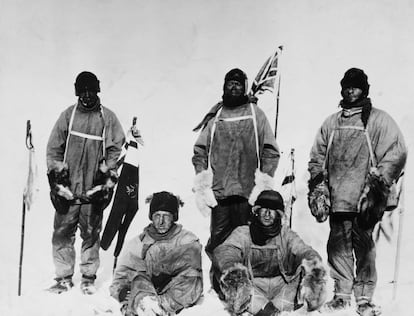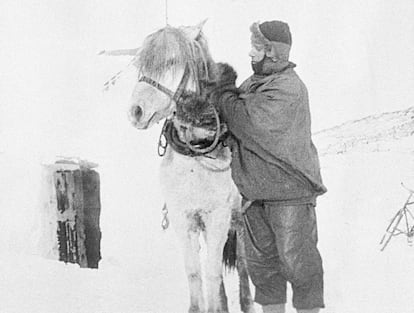Reaching the South Pole on foot: tougher than competing in eight Tours de France in a row
More than a century after Robert Falcon Scott’s death, the physiological challenge necessary to follow in the pioneers’ footsteps remains as mysterious as it is complex

Robert Falcon Scott is to the South Pole what Raymond Poulidor is to the Tour de France: the “eternal second.” This is how history remembers him, and it has not forgiven him, despite he and the men he dragged along with him dying in the effort in 1912. His critics say that his planning for the Antarctic trip was disastrous, and what should have been a moment of pride for the British Empire led to a surprising Norwegian success, and Roald Amundsen unintentionally exposed all the shortcomings of Scott’s team.
However, seen from the current perspective of two physiologists and researchers, two stalwarts of the study of metabolism, Adrián Castillo and Aitor Viribay, what Scott and his team did is possibly the greatest physiological feat ever carried out. Scott was many things, but not an athlete in the modern sense of the term. Viribay, who is in charge of the nutrition of the INEOS team cyclists, is congratulated if a cyclist manages to finish the Tour de France at the same weight that he started it. Scott, who was of average weight, lost 88 pounds during the five months of his round trip to the South Pole. So the analogy may be accurate. Scott’s trip was much more demanding than competing in eight Tours de France in a row without a day’s rest. But why is that?
“There are factors that make this expedition unique, especially if we compare them with feats of sporting performance such as the Tour. Currently, most scientists whose focus is on the limits of metabolism point to the French race as the paradigm of the maximum energy expenditure that a human can sustain over a period of many days. We are talking about between 6,000-7,000 kcal daily, some even more, reaching 10,000, for 21 days. The difference is that cyclists consume a large number of calories before, during, and after each stage. In fact, and Viribay is a world expert in this. One of the big differences that is currently being seen in the performance of cyclists is that the limit of how much they can eat is being pushed ever forward. Every day they recover what they expended on each stage. In addition, they rest for about 14 or 16 hours between stages, in comfortable hotels, in temperatures that do not put their lives at risk,” explains Adrián Castillo.
Explorers at the beginning of the 20th century endured temperatures of up to 40 degrees below zero (coincidentally this is where Celsius and Fahrenheit coincide), terrible katabatic winds, in addition to walking on a frozen desert. The English wore wool suits, less effective than the furs worn by the Norwegians, which they imitated from Arctic tribespeople.
On the Terra Nova expedition, Scott and his team dragged all the material and food they had to eat themselves. That means they pulled sleds weighing about 220 pounds each. On the other hand, Amundsen’s team moved on skis and had efficient dogs to pull the loads. Scott chose horses and a kind of motorized sled. The animals sank hopelessly in the snow and soon died, while the mechanical traction quickly stopped working, forcing the team to advance on foot, loaded like mules.
“As they miscalculated the amount of food, they had daily deficits of between 1,500 and 2,400 kcal. They burned off much more than they consumed. All that in a unique environment: Antarctica is the highest continent on the planet. The Antarctic plateau is on average of 9,800 feet above sea level and has peaks of 13,000 feet. The lack of oxygen at these altitudes causes hypoxia in the body. This hypoxia is what cyclists undergo in their preparation camps, which last one or two weeks. At such altitudes, energy demands multiply. The body wastes away. It took Scott and his team five months to travel nearly 1,500 miles! But, above all, they were affected by the extreme cold, to which humans can never adapt and which burns a lot of calories. Extreme cold, altitude, and energy deficit cause the body to gradually waste away,” Castillo summarizes.
Overall, the Norwegians’ energy efficiency was higher. Scott and his men were subjected to a death spiral. A cyclist would have abandoned the race, but the explorers carried on in a brutal flight forward... without coldly considering that once they reached the South Pole they had to return. “It’s a Catch-22. You have to move so as not to die from the cold. To do so you need to eat a lot, and to eat a lot you need to carry very heavy sleds, and to carry very heavy sleds, you have to burn… anguish,” summarizes Viribay.
Scott and his four men reached the South Pole on January 17, 1912, to find that Amundsen had gotten there five weeks earlier. Just a month later, during the return trip that Scott predicted would be “terribly exhausting and monotonous,” Edgar Evans died. His body just shut down. Lawrence Oates held out for another month, but when he could no longer walk, afflicted by an old war wound, he left the store and walked far enough away to let himself freeze to death. His last words were these: “I’m going to go outside and maybe for a while.”
Scott, Henry Bowers, and Edward Wilson would still manage to advance 18 miles more until they were just 12 miles from a food depot. By now, they should have received help from an English team that was to bring dog sleds and food from the coast. Such a meeting never took place, due to a new administrative error.

Eight months later, they found the three bodies. It is presumed that Scott was the last to die. His body had wasted away. “Our brain is the organ in charge of distributing energy reserves. If we can eat enough and there is a balance between intake and expenditure, the brain distributes energy to all our organs, maintaining what is known as physiological balance or homeostasis. The problem lies when the energy expenditure (in Scott’s case from physical activity, cold, and altitude) is so excessive that we do not sufficiently satisfy the energy demands that the organs need to fulfill their vital functions. The brain distributes this energy, and when it sees that there is little left, it begins to shut systems down in order to save energy. It is a defense mechanism. Even if we want to increase activity, the brain puts obstacles in the way because it estimates that if expenditure increases, the remaining energy may not be enough to keep the body alive. It’s a domino effect. The body enters a kind of hibernation. A as it loses weight, the organs gradually stop functioning. It consumes itself,” explains Castillo.
The Englishmen’s daily ration in Antarctica was based on Pemmican (a type of energy bar composed of dried berries, pulverized dried meat, and fats), butter, biscuits, sugar, chocolate, cereal, raisins, and cocoa (about 4,200 kcal), but it provided a higher proportion of protein than necessary: “In Scott’s case, surely a readjustment in macronutrients, with an increase in carbohydrates and fats, that increased calories, could have stopped the decline. However, energy intake limits also seem to put a brake (we still don’t really know which one) on the ability to eat very high calorie food for such a long time. Is it possible to eat more than 6,000 calories every day? Even today we do not know the answer, but there does seem to be a food limit,” says Viribay.
In the Race Across America, runners cross the United States from California to Washington D.C., running the equivalent of six marathons a week for approximately 20 weeks: “This challenge shows how energy expenditure readjusts to prolonged demands. A study that measured these athletes saw that at the beginning of the race the runners spent about 6,200 kcal daily. However, towards the end of the 20 weeks, this expenditure decreased to about 5,300 kcal per day. They couldn’t sustain such high expenditure for so long. Even if energy is available, it seems that the body readjusts to reduce its metabolic rate. Humans cannot expend unlimited energy,” explains Adrián Castillo.
More than a century after the death of Scott and his men, reaching the South Pole on foot and returning alive remains a near impossible challenge. It is a sporting and physiological feat of such magnitude that racing in the Tour or climbing Everest seem, in comparison, mere entertainment.
Sign up for our weekly newsletter to get more English-language news coverage from EL PAÍS USA Edition
Tu suscripción se está usando en otro dispositivo
¿Quieres añadir otro usuario a tu suscripción?
Si continúas leyendo en este dispositivo, no se podrá leer en el otro.
FlechaTu suscripción se está usando en otro dispositivo y solo puedes acceder a EL PAÍS desde un dispositivo a la vez.
Si quieres compartir tu cuenta, cambia tu suscripción a la modalidad Premium, así podrás añadir otro usuario. Cada uno accederá con su propia cuenta de email, lo que os permitirá personalizar vuestra experiencia en EL PAÍS.
¿Tienes una suscripción de empresa? Accede aquí para contratar más cuentas.
En el caso de no saber quién está usando tu cuenta, te recomendamos cambiar tu contraseña aquí.
Si decides continuar compartiendo tu cuenta, este mensaje se mostrará en tu dispositivo y en el de la otra persona que está usando tu cuenta de forma indefinida, afectando a tu experiencia de lectura. Puedes consultar aquí los términos y condiciones de la suscripción digital.
More information
Últimas noticias
Most viewed
- Sinaloa Cartel war is taking its toll on Los Chapitos
- Oona Chaplin: ‘I told James Cameron that I was living in a treehouse and starting a permaculture project with a friend’
- Reinhard Genzel, Nobel laureate in physics: ‘One-minute videos will never give you the truth’
- Why the price of coffee has skyrocketed: from Brazilian plantations to specialty coffee houses
- Silver prices are going crazy: This is what’s fueling the rally










































